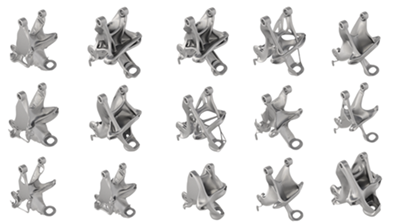& Construction

Integrated BIM tools, including Revit, AutoCAD, and Civil 3D
& Manufacturing

Professional CAD/CAM tools built on Inventor and AutoCAD
3 min read

Cloud architecture changes everything and is driving dramatic shifts in software licensing, technology deployment, and data accessibility. The internet and cloud architecture have given rise to new computing devices and on-line productivity applications. Today, mobile computing devices such as smart phones and tablets are the devices of choice for finding and sharing information. With cloud applications, your data is in one place, not scattered across multiple computer hard drives or data servers, is accessible from any device, and is always available. More importantly, cloud computing provides an opportunity to offer capabilities as a service that can be accessed when required.
Cloud computing is also changing how engineering and manufacturing data is created, accessed and shared, driving this next wave of engineering tools democratization. Fusion 360 is at the forefront of this industry shift. The blend of on-device and cloud services Fusion 360 provides is the best of both worlds. It is truly design re-imagined – new tools, system architecture, and workflows developed from the ground up to take advantage of the transformative power of the cloud, device independence to leverage the preferred computing devices in use today, and access to CAD data, anytime, anywhere, any device.
Autodesk Fusion 360 is pioneering new methods for access to engineering and manufacturing tools that are unlocking the availability of high-end tools and capabilities that have been the domain of the very few. These innovations are changing the CAD industry as we know it, providing capabilities to every designer or engineer that were previously unattainable because of cost or implementation challenges.
The first innovation was offering engineering software as a service, a software licensing model where Fusion 360 is delivered on a subscription basis, the application data is centrally hosted, and elements of the application are services accessible via the cloud. Engineering tools are available by anyone, anytime, and anywhere for a fraction of the cost of the old model – acquiring expensive perpetual software licenses locked to a workstation.
The next innovation was consumption-based services. All commercial Fusion 360 subscribers have access to high-end generative design, simulation, rendering, and manufacturing capabilities as consumption services. There is no longer a requirement to acquire expensive perpetual software licenses for capabilities that may only be used on an infrequent basis or contracting an engineering services firm for their access to or expertise with these tools.
Generative design is a design exploration service that delivers hundreds of design alternatives for consideration and trade-off studies in less time than a human can develop and evaluate 1 or 2 alternatives. Generative design exposes the design team to a greater number of potential manufacturing-aware solutions to a specific set of design constraints, saving time and offering alternatives they wouldn’t have otherwise imagined or considered. The design team is then able to review all the design alternatives returned, assess the trade-offs, and then decide which design alternatives they want to download to take forward.
Instead of the current practice of defining a CAD model before validation can take place, the engineer spends his time describing the engineering challenge, specifying performance criteria and constraints that define the design and manufacturing goals. With generative design, the designer or engineer defines only minimal geometry – connection points, hold out areas, and space claim envelopes, not a complete CAD model. The generative design engine, not the engineer then creates all valid CAD model topology options based on the specified constraints, exposing a wide range of potential design options for consideration and trade-off studies that are manufacturing aware. Please see this blog post “Do you aspire to be great at CAD, or to be a Great Engineer?” for a detailed discussion on the value of generative design.

Autodesk Fusion 360 has democratized what has been until now expensive technology available only to the select few that could afford it. Now, every engineer or designer has access to all the tools he needs on-demand. It is no longer a question of whether one can afford the engineering tools required to get the job done. Autodesk makes Fusion 360 easily justifiable; it is only a question if one will benefit from the capabilities. If so, purchasing Fusion 360 is an easy, affordable transaction on the Autodesk Store, providing access to every stakeholder that can benefit from access to project data and tools.
The days of expensive high-end engineering capabilities only available as a perpetual license are now a thing of the past, and Autodesk is leading the way.
Isn’t it about time you tried Fusion 360?
By clicking subscribe, I agree to receive the Fusion newsletter and acknowledge the Autodesk Privacy Statement.
Success!
May we collect and use your data?
Learn more about the Third Party Services we use and our Privacy Statement.May we collect and use your data to tailor your experience?
Explore the benefits of a customized experience by managing your privacy settings for this site or visit our Privacy Statement to learn more about your options.